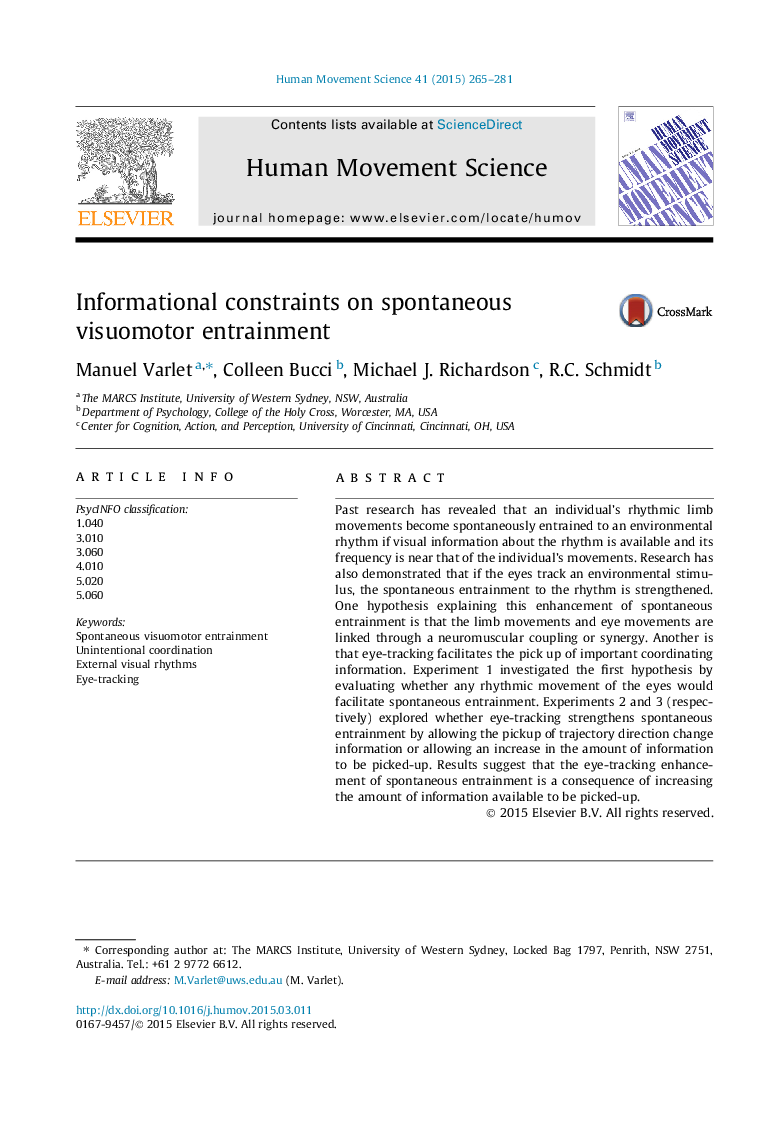| کد مقاله | کد نشریه | سال انتشار | مقاله انگلیسی | نسخه تمام متن |
|---|---|---|---|---|
| 7292047 | 1474224 | 2015 | 17 صفحه PDF | دانلود رایگان |
عنوان انگلیسی مقاله ISI
Informational constraints on spontaneous visuomotor entrainment
ترجمه فارسی عنوان
محدودیت های اطلاعاتی در مورد تحریک عضلانی خود به خودی
دانلود مقاله + سفارش ترجمه
دانلود مقاله ISI انگلیسی
رایگان برای ایرانیان
کلمات کلیدی
1.040، 3.010، 3.060، 4.010، 5.020، 5.060، جذب عضلانی خود به خودی، هماهنگی غیرمستقیم، ریتم های بصری خارجی، ردیابی چشم،
ترجمه چکیده
تحقیقات گذشته نشان داده است که حرکات اندام حرکتی فرد به طور خودبهخودی به ریتم زیست محیطی منتقل می شود اگر اطلاعات بصری در مورد ریتم موجود باشد و فرکانس آن نزدیک به حرکات فرد باشد. تحقیقات همچنین نشان داده است که اگر چشم ها یک محرک زیست محیطی را دنبال کنند، جذب خود به خود به ریتم تقویت می شود. یک فرضیه توضیح دهنده این افزایش جذب خودبهخود این است که حرکات اندام و حرکات چشم از طریق یک اتصال یا عضلانی عضلانی ارتباط پیدا می کنند. یکی دیگر از این است که ردیابی چشم، جمع آوری اطلاعات هماهنگ کننده مهم را آسان می کند. آزمایش 1 نخستین فرضیه را با بررسی اینکه آیا هر حرکت ریتمیک چشم، جذب خود به خود را تسهیل می کند، مورد بررسی قرار داد. آزمایشها 2 و 3 (به ترتیب) بررسی کردند که آیا ردیابی چشم، تقویت خود به خودی را تقویت می کند یا اینکه اجازه می دهد تا اطلاعات مسیر تغییر مسیر را افزایش دهد یا به افزایش مقدار اطلاعات منتهی شود. نتایج حاکی از آن است که افزایش ردیابی چشم، افزایش جذب خودبهخودی ناشی از افزایش میزان اطلاعات موجود برای برداشت است.
موضوعات مرتبط
علوم زیستی و بیوفناوری
علم عصب شناسی
علوم اعصاب شناختی
چکیده انگلیسی
Past research has revealed that an individual's rhythmic limb movements become spontaneously entrained to an environmental rhythm if visual information about the rhythm is available and its frequency is near that of the individual's movements. Research has also demonstrated that if the eyes track an environmental stimulus, the spontaneous entrainment to the rhythm is strengthened. One hypothesis explaining this enhancement of spontaneous entrainment is that the limb movements and eye movements are linked through a neuromuscular coupling or synergy. Another is that eye-tracking facilitates the pick up of important coordinating information. Experiment 1 investigated the first hypothesis by evaluating whether any rhythmic movement of the eyes would facilitate spontaneous entrainment. Experiments 2 and 3 (respectively) explored whether eye-tracking strengthens spontaneous entrainment by allowing the pickup of trajectory direction change information or allowing an increase in the amount of information to be picked-up. Results suggest that the eye-tracking enhancement of spontaneous entrainment is a consequence of increasing the amount of information available to be picked-up.
ناشر
Database: Elsevier - ScienceDirect (ساینس دایرکت)
Journal: Human Movement Science - Volume 41, June 2015, Pages 265-281
Journal: Human Movement Science - Volume 41, June 2015, Pages 265-281
نویسندگان
Manuel Varlet, Colleen Bucci, Michael J. Richardson, R.C. Schmidt,
